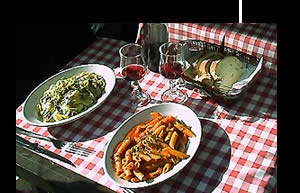|
Italian Cuisine
Cuisine is definitely a very important aspect
of Italian culture. Italian food is highly famed: greatly
loved and tirelessly imitated the world over, it has been
a source of endless pleasure and joie-de-vivre in countries
far and wide. And everyone knows how a tired, depressed individual
will react if they come across a sign for Italian dining in
the midst of a busy, industrial city anywhere in the world:
their hearts will quite simply will glow!
Italian cookery is exceptionally varied, nutritious
and healthy; traditions have been handed down from one family
to the next over the centuries, and are associated mainly
with country life in that dishes are directly linked to what
the Earth produces over the changing seasons: in other words,
wholesome cooking whose goodness depends on all-natural ingredients.
Italian cooking is full of marvellous single pasta dishes
made with all types of vegetables and pulses. These are also
the prime ingredients for many local specialities though countless
types of meat dishes abound, as well as fine fish from the
plentiful seas around the peninsula, fragrant cheeses and
exceptional desserts. But the undisputed star of Italian dining
is the famous “first course”, in all its many varieties,
including pasta “dry” or in broth, soups, many kinds
of noodle soups and minestrones, risottos and timbales.
It must always be remembered that generally
speaking, the origins of the most widely known traditional
dishes derive from humble peasant cooking and from what was
eaten by the poorer classes, which over the years have transformed
into veritable “specialities”: one only has to think
of soups made from stale bread and vegetables, such as the
“ribollita” or the “acquacotta”
from Tuscany, and many more recipes containing fairly modest
ingredients that have nonetheless become absolute “classics”
of Italian cookery. All of this goes to show that the goodness
of any dish depends above all on the magical combination (always
“unique”) achieved through an unrepeatable fusion
of flavours and aroma, cooking times and the balancing of
single ingredients, individual “creative” skills
and care taken over all stages of preparation. At times all
that’s needed in cookery is a single detail or a tiny
touch to transform an ordinary dish by “normal”
standards into a veritable triumph of taste. Passion therefore
is a fundamental requisite of Italian cooking and without
it, as with life in general, not much can be achieved. Regardless
of any local differences, the most classic dishes in Italian
cookery are kept alive across the nation, and are turned into
more sophisticated delicacies when spiced up with a fuller
range of ingredients by the skilful hand of a creative chef.
And now let’s look at how a typical Italian-style
lunch might be prepared. A good starter might be an hors
d’oevres of Neapolitan croutons and then, when palates
have been suitably satiated with such typically Mediterranean
flavours, maccheroni with Sicilian broccoli would make
a fine first course to follow. After that comes the second
course which could be a splendid roast leg of mutton with
new potatoes. And that might be as far as it goes! But
a tiny space can always be found for dessert: a fragrant tiramisù
makes an excellent tail-piece to any fine lunch “with
bows on”!!
home
|
|











